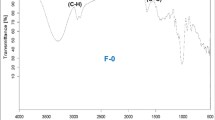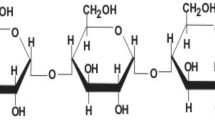Abstract
Cellulose ester derivatives having phosphoryl side-chains were synthesized by phosphorylation of two types of cellulose propionate (CP); the difference between the two CPs was whether the primary hydroxyl group at C6 had been fully propionylated or not. Dimethyl phosphate, dimethyl thiophosphate, diethyl phosphate, or diethyl thiophosphate was introduced into the residual hydroxyl positions of the CPs. Chemical composition of the respective derivatives was characterized by elemental analysis and a combined use of saponification and HPLC quantification of the released propionic acid. Their thermal properties were investigated by DSC and TGA, and an intermediate residue of the pyrolysis was also examined by FT-IR spectroscopy. From the thermal degradation measurements using TGA, the C6-O phosphorylation was found to noticeably prevent the CP derivatives from weight loss in the pyrolysis process under dynamic air, i.e., providing them with a flame-resistance functionality, whereas the C2-O and C3-O phosphorylation did not give rise to such an appreciable resistance effect. A discussion was focused on the difference in pyrolysis mechanism between the phosphorylated CPs. However, most samples of the CP derivatives showed a clear T g considerably lower than the onset temperature of the thermal degradation. Thus we suggest that it is possible to design thermoplastic flame resistant/retardant materials based on cellulose, by controlling the substitution distribution of the phosphoryl and propionyl groups introduced.







Similar content being viewed by others
References
Balabanovich AI, Balabanovich AM, Engelmann J (2003) Intumescence in poly(butylene terephthalate): the effect of 2-methyl-1, 2-oxaphospholan-5-one 2-oxide and ammonium polyphosphate. Polymer Int 52:1309–1314
Bourbigot S, Le Bras M, Delobel R, Bréant P, Trémillon JM (1995) Carbonization mechanisms resulting from intumescence—part II. Association with an ethylene terpolymer and the ammonium polyphosphoate-pentaerythritol fire retardant system. Carbon 33:283–294
Dobele G, Rossinskaja G, Telysheva G, Meier D, Faix O (1999) Cellulose dehydration and depolymerization reactions during pyrolysis in the presence of phosphoric acid. J Anal Appl Pyrolysis 49:307–317
El Seoud OA, Heinze T (2005) Organic esters of cellulose: new perspectives for old polymers. Adv Polym Sci 186:103–149
Gottlieb IM (1956) A theory of flame-retardant finishes. Text Res J 26:156–167
Harada T, Yamanaka Y, Yaginuma H, Nishio Y, Aoki D (2010) Japan Patent, JP2010-31230A
Jain RK, Lal K, Bhatnagar HL (1985) Thermal, morphological, X-ray and spectroscopic studies on cellulose and its esters. J Anal Appl Pyrolysis 8:359–389
Kandola BK, Horrocks AR (1996) Complex char formation in flame-retarded fibre-intumescent combinations—II. Thermal analytical studies. Polymer Degrad Stab 54:289–303
Kandola BK, Horrocks AR, Price D, Coleman GV (1996) Flame-retardant treatments of cellulose and their influence on the mechanism of cellulose pyrolysis. J M S Rev Macromol Chem Phys C36:721–794
Karakawa M, Takano T, Nakatsubo F (2007) Copolymerization of (-D-glucopyranose 1, 2, 4-ortho pivalate derivatives. Preparation of O-methyl celluloses with heterogeneous distribution of the methyl groups and their water solubility. Cellulose Chem Technol 41:555–561
Katsuura K, Inagaki N (1978) Flame-retardant properties of cellulose phenylthiophosphonate. J Appl Polym Sci 22:679–687
Kaur B, Gur IS, Bhatnagar HL (1987) Thermal degradation studies of cellulose phosphates and cellulose thiophosphates. Angew Makromol Chem 147:157–183
Klemm D, Heublein B, Fink HP, Bohn A (2005) Cellulose: fascinating biopolymer and sustainable raw material. Angew Chem Int Ed 44:3358–3393
Luneva NK, Oputina AG (1997) Synthesis and properties of new esters of cellulose and inorganic polyacids containing phosphorus, molybdenum, tungsten and vanadium. Polym Eng Sci 37:940–944
McKee DW, Spiro CL, Lamby EJ (1984) The inhibition of graphite oxidation by phosphorus additives. Carbon 22:285–290
Nehls I, Wagenknecht W, Philipp B, Stscherbina D (1994) Characterization of cellulose and cellulose derivatives in solution by high resolution 13C-NMR spectroscopy. Prog Polym Sci 19:29–78
Nishio Y (2006) Material functionalization of cellulose and related polysaccharides via diverse microcompositions. Adv Polym Sci 205:97–151
Nishio Y, Roy SK, Manley RStJ (1987) Blends of cellulose with polyacrylonitrile prepared from N, N-dimethylacetamide—lithium chloride solutions. Polymer 28:1385–1390
Nishio Y, Matsuda K, Miyashita Y, Kimura N, Suzuki H (1997) Blends of poly(ε-caprolactone) with cellulose alkyl esters: effect of the alkyl side-chain length and degree of substitution on miscibility. Cellulose 4:131–145
Pacsu E, Schwenker RF Jr (1957) The effect of chemical modification on the flame and glow resistance of cotton cellulose. Text Res J 27:173–175
Price D, Horrocks AR, Akalin M, Faroq AA (1997) Influence of flame retardants on the mechanism of pyrolysis of cotton (cellulose) fabrics in air. J Anal Appl Pyrolysis 40–41:511–524
Scotney A (1972) The thermal degradation of cellulose triacetate—I. The reaction products. Euro Polymer J 8:163–174
Singh BP, Srivastava G, Mehrotra RC (1979) Synthesis and reactions of triorganotin dialkyldithiophosphates. J Organometal Chem 171:35–41
Suárez-García F, Martínez-Alonso A, Tascón JMD (2002) A comparative study of the thermal decomposition of apple pulp in the absence and presence of phosphoric acid. Polymer Degrad Stab 75:375–383
Tezuka Y, Tsuchiya Y (1995) Determination of substituent distribution in cellulose acetate by means of a 13C NMR study on its propanoated derivative. Carbohydr Res 273:83–91
Yamanaka Y, Harada T, Yaginuma H, Nishio Y, Aoki D (2010) Japan Patent, JP2010-31229A
Acknowledgments
This work was partially financed by a Grant-in-Aid for Scientific Research (A) (No. 20248019 to YN) from the Japan Society for the Promotion of Science.
Author information
Authors and Affiliations
Corresponding author
Rights and permissions
About this article
Cite this article
Aoki, D., Nishio, Y. Phosphorylated cellulose propionate derivatives as thermoplastic flame resistant/retardant materials: influence of regioselective phosphorylation on their thermal degradation behaviour. Cellulose 17, 963–976 (2010). https://doi.org/10.1007/s10570-010-9440-8
Received:
Accepted:
Published:
Issue Date:
DOI: https://doi.org/10.1007/s10570-010-9440-8




